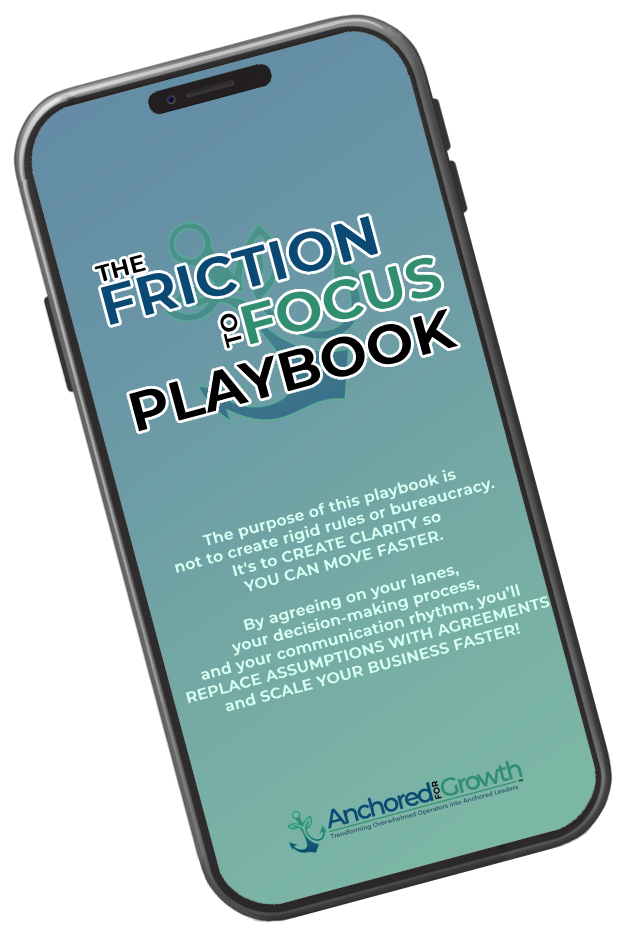Stop the Friction. Start Focusing, then Scaling.
The relationship between the founder/CEO and the COO is a paradox. It is both the most powerful engine for growth and the most common source of friction in a startup. As a co-founder and COO myself, I have lived this dynamic. In one of my previous businesses, my Co-Founding CEO and I, both with ADHD, often found ourselves in a whirlwind of shared vision and maddening role ambiguity.
We uncovered a framework that not only aligned us but also propelled us to our biggest sales year and helped us raise significant venture funding. It cleared the way for growth. This guide will show you how to build that same unstoppable partnership by turning friction into momentum.
The Traction Breakthrough: Defining Visionary and Integrator
Our business came together over numerous late nights, pizza, and a shared desire to solve a problem and change the trajectory of every student we had. For more than 2 years, we made slow progress—we struggled, stepped on each other’s feet, and held each other accountable for unrealistic responsibilities.
A mentor recommended Gino Wickman’s book, Traction, and it was a paramount game-changer. It gave us the language and framework to get on the same page, finally. The book defines two key roles essential to a growing business:
- The Visionary (often the CEO): This person sets the course. They are the strategic, big-picture thinker who defines the direction the company will move in.
- The Integrator (often the COO): This person steers the ship. Once the course is set, all execution-related decisions fall to the COO. The CEO reports to them before enforcing a change in execution.
My co-founder and I had many similar skills and personality traits. We both were good at graphic design, marketing, and product development. We also both had ADHD. His behaviors were much more apparent, and he had a combination of hyperactive and inattentive/impulsive ADHD. At the time, I was unaware of my neurodivergence, which is much more internal and tends to be on the inattentive side more than outwardly hyperactive.
This overlap created significant role ambiguity and, as a 2021 study in the Journal of Organizational Behavior confirms, such ambiguity is a significant source of stress and reduced team performance. Once we defined our roles using Traction and the framework below as a guide, it paved the way to incredible growth, less resentment, more accountability, and ultimately, more fun.
Consider This Post: The Anchor & Balloon: A New Model for the Visionary & Integrator – The Visionary/Integrator framework is powerful. This article introduces my core philosophy, The Anchor & Balloon, as a new, more intuitive way to understand this critical partnership dynamic.
Uncovering Your Shared Superpowers: The Role Definition Deep Dive
Before these conversations, we would get frustrated and hold onto resentment —the number one killer of any relationship, progress, and positive growth. I had assumed he had handled communicating with one of our clients, while he had assumed I had completed the pitch deck for the next investor. When, in fact, neither had been completed.
To truly determine our roles, we decided to change our environment. Our office and even our hometown felt too familiar. We took a train up to New York City for a weekend-long trip, pretty much stayed in the hotel during the days, and talked it over. This was a critical step, as changing your environment can alter your mood, boost creativity, and reduce tension.
Then, we went through a simple but powerful process:
- List All Business Functions: We wrote down every major function in the business: Sales, Marketing, HR, Finance, Product, and Operations…
- Conduct a Time Audit: We reviewed our calendars and task lists to see how we were actually spending our time, not just how we thought we were.
Pro Tip: Peter Drucker, management expert, famously said, “Show me your calendar and your bank statements, I will show you what you really value.” In business, these tend to be your priorities and, while that may not be exactly accurate, it will shine a bright light at what is important to your role and business.
- Evaluate Strengths and Energy: We honestly assessed each other’s strengths and, just as importantly, what work energized us, or fed our dopamine.
Consider This Post: Imposter Syndrome in Executive Leadership – The process of defining your role and owning your strengths is a powerful antidote to imposter syndrome. If you’ve ever felt like a fraud, this guide will help you reframe that feeling as a sign of growth.
The insights were revealing. While the role of accounting and finance may typically fall to a COO, my partner was far superior in this area than I was. Given his role in investor relationships, it made more sense for him to take on the finances entirely.
The decision to remove finances from my responsibilities allowed me to focus on what I did best and what excited me to work on, such as building our operational systems, managing our marketing campaigns, and building an award-winning team.

Ready to End the Friction and Find Your Focus?
Reading about a better partnership is the first step. Building it is the next step.
To help you and your founder immediately apply these strategies, I’ve created The Friction to Focus Playbook. This isn’t just a template; it’s a guided mini-workshop designed to help you:
- Audit your current roles and uncover hidden overlaps.
- Define clear lanes for both the Visionary and Integrator.
- Establish a Decision Rights Matrix to eliminate bottlenecks.
- Implement a communication rhythm that drives clarity, not chaos.
Download your free playbook now and transform your partnership into your company’s greatest advantage.
Taming the Idea Tornado: A Guide to Divergent and Convergent Thinking
A founder’s brilliant ideas fuel growth, but for a COO with ADHD, they can quickly become overwhelming, leading to shiny-object syndrome. The key is to build a system that honors the creative process without sacrificing focus. This is where understanding Divergent and Convergent thinking becomes a superpower.
Divergent thinking is the creative, non-linear process of exploring many possible solutions. It is about generating a high volume of ideas without judgment. This is the natural territory of the Visionary. Their brain is wired to ask “What if?” as explained by ADDitude Magazine, and this ability to generate a high volume of novel ideas is a superpower of the ADHD brain.
Convergent thinking, on the other hand, is the logical, linear process of evaluating options to find a single, best solution. It is about analysis, prioritization, and making decisions. This is the domain of the Integrator/COO, but can also be a challenge if your brain is wired to seek out novelty and new experiences (a component of ADHD and other neurodiversities).
The friction in a CEO-COO relationship often comes from a mismatch of these thinking styles in the moment. The solution is to create a system that allows both styles to thrive in the proper sequence.
My best advice is to create an Idea Dock. This is a dedicated place, like a shared document or project board, where all new ideas go immediately. This respects the Visionary’s divergent process, capturing their valuable insights without derailing the company’s current priorities. Our brains aren’t wired to remember things. So, having a dedicated place to write them down allows for more ideas to be generated.
Then, on a regular cadence (e.g., monthly), the Visionary and Integrator come together to apply convergent thinking to the Idea Dock. This is where the COO’s role is critical. You guide the process of funneling those brilliant, divergent ideas into a single, executable plan:
- Review and Cluster: Look at all the ideas generated, without judgment.
- Narrow to the Top 5: Collaboratively select the ideas with the most strategic potential.
- Scope the Top 3: Briefly outline what an MVP (Minimum Viable Product) would look like for the top three contenders.
- Commit to One: Make a clear decision on the single idea to execute for the next cycle.
This framework transforms the “Idea Tornado” from a chaotic force into a powerful, predictable engine for innovation. It allows the Visionary to diverge freely while empowering the Integrator to provide the convergent focus needed to turn those ideas into reality.
The COO’s role is to help channel that creativity through a simple funnel: Write down all the ideas. Narrow them to the top 5. Build an MVP for 3. Execute on 1.
Making Decisions Without Compromise: Collaborate, Collaborate, Collaborate, Decide
I hate the idea of compromise. Often, you get the worst version of a solution because each party is unwilling to bend in the areas that are the most important to them – and that is what all the disagreeing is about. A better framework is Collaborate, Collaborate, Dictate.
The first step is to determine what each person wants and talk it out loud, without heightened emotion. Then, collaborate to find a new, collective solution that works for everyone and delivers what they truly care about. If a perfect solution is not obvious, which it often isn’t, collaborate again. This takes practice, divergent thinking, open and honest communication, and time — especially if multiple people are involved. Continue iterating and exploring options, ensuring every voice is heard. Finally, if a shared path cannot be found, the Integrator or COO must decide, or dictate.
You make the final decision based on the information available and the company’s best interests. As the COO, you may know aspects of the business that others do not. Explain what you can to build understanding, even if agreement is not total.
You will find that not everyone will agree, but through listening to their thoughts, feedback, and reasons, you can try to decide in a way that incorporates as many of these ideas as possible. Agreeing isn’t the goal; committing to move forward together is.
In these moments, we had every team member say either “Agree and Commit” or “Disagree and Commit.” If they disagreed, this was their time to say why, and then we moved on. All voices were heard and valued. Either way, we move forward together.
The Unbreakable Anchor: Your Role as the Realistic COO
As the COO, you have to be brutally honest about your own capacity and the company’s. You need to have your finger on the pulse and know what is going on in all aspects of the company at any given time. However, this unique position can easily make you feel like the designated “No” person — a mindset you will need to overcome.
Pro Tip: The truth is, every time you say ‘Yes’ to one thing, you are inherently saying ‘No’ to something else. Your role is not to be a naysayer, but to be the person who clearly illuminates the trade-offs. You protect the company’s momentum by ensuring every new “Yes” is intentional and its consequences are understood.
To do this, shift your language from shutting down ideas to exploring their possibilities. Instead of a “Yes, but…” which negates the idea, adopt the improv principle of “Yes, and…” This simple change builds on the idea rather than tearing it down. When your founder has a brilliant new idea, your response can be, “Yes, that’s an exciting direction, and for us to do it well, we would need to shift our focus from Project X.”
Consider This Post: ADHD Executive Coaching: A Playbook for the Modern Operator – Building a strong founder partnership is a core leadership skill. This guide provides a complete playbook for turning your personal ADHD challenges into your greatest leadership strengths.
This naturally leads to another powerful phrase: “How Might We…?” This question transforms a potential conflict into a collaborative problem-solving session. It conveys, “WE are in this together and I, genuinely, care about the outcome that we are both happy with.”
- “How might we work toward implementing that idea in the upcoming quarter?”
- “How might we solve this problem together with our current resources?”
This “How Might We…” sentence is also ideal for customer support or supply-chain interruptions. “How might we work together to resolve this so that you get what you want [fill in the blank] and I feel like a valued customer?” But, be genuine about it; everyone can feel when you aren’t.
This approach is especially powerful when your CEO is stuck between two choices or wants to change an already set goal. As a parent and manager (you’d be surprised how often these overlap), I quickly learned not to say “no,” but to offer my daughter two choices, both of which I favored. This empowers her to decide. The same concept works wonders with your team members and the CEO. By presenting two viable options, you honor their role as the ultimate decision-maker while ensuring either choice keeps the company moving in a healthy direction.
Consider This Post: The Anchored Operator’s Guide to Running a Weekly Leadership Meeting That Doesn’t Suck – A great meeting agenda is a powerful tool, but its success often depends on the underlying dynamics between the leaders. This guide provides a framework for building the alignment and role clarity needed to make your partnership truly effective.
Conclusion: An Unstoppable Force for Growth
The founder/CEO COO relationship is the central nervous system of a scaling company. When it is misaligned, the entire organization feels the friction. Resentment builds, momentum stalls, and brilliant ideas die on the vine of poor execution. But when it is intentionally designed and nurtured, it becomes an unstoppable force for growth.
The solution is not to change who you are. It is not about forcing the Visionary to stop dreaming or the ADHD COO to operate like a neurotypical executive. Instead, the path to alignment is paved with shared language and robust systems. It is about trading ambiguity for absolute role clarity, replacing chaotic brainstorming with a structured process for divergent and convergent thinking, and shifting from compromise to true collaboration.
As the COO, you are the unbreakable anchor. Your role is not to be the source of “no,” but the source of clarity. By using frameworks like “Yes, and…” and asking “How might we…?”, you transform potential conflict into collaborative problem-solving, guiding your founder’s vision with a realistic and empowering plan.
This intentional structure does not just build a better company; it builds a more resilient, respectful, and ultimately more enjoyable partnership. It creates an environment where both the founder and the COO can do their best work, turning your unique partnership into your company’s greatest competitive advantage.
Ready to Build Your Unstoppable Partnership?
This guide provides the frameworks to turn friction into focus. But applying them to the
unique dynamics of your partnership is where the real transformation happens.
If you’re ready to go beyond reading and start implementing, a complimentary Clarity Call
is your best next step. In this private session, we’ll diagnose the root cause of your founder friction,
identify your biggest opportunities for alignment, and map out a clear plan to
build the unbreakable partnership your company needs to scale.
Frequently Asked Questions About the Founder/CEO & COO Relationship
Want More Actionable Systems Like This?
⚓ Join The Anchored Insights ⚓
The insights in this article are just the beginning. The journey from an overwhelmed operator to an anchored leader is built on a foundation of consistent, practical strategies.
Once a month, I send out a private email with my single best, battle-tested insight for COOs and Operators alike. This includes new systems, ADHD-friendly productivity tips, and frameworks to help you calm the chaos and lead with confidence.
No fluff. No daily spam. Just one high-value email per month designed to be your anchor in the storm.







